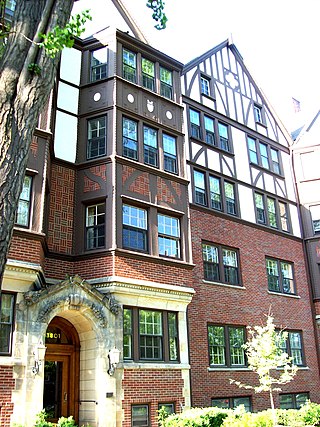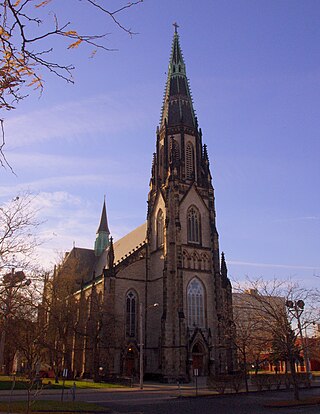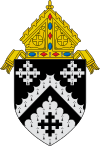
Buckeye–Shaker is a neighborhood on the East Side of Cleveland, Ohio. It encompasses two sub neighborhoods: in its south and west, the old Buckeye neighborhood; and in its northeast, the Shaker Square neighborhood, which is centered on a historic shopping district and an eponymous rapid transit station, located at the intersection of Shaker and Moreland Boulevards, on the light rail line that connects the city of Shaker Heights to downtown Cleveland. From the early to mid-20th century, the Buckeye Road neighborhood was known as "Little Hungary", serving as the historic heart of Cleveland's Hungarian community, which at one time was the largest in the world outside of Hungary and for years has been almost completely African-American. Shaker Square, continues to be known as one of Cleveland's most notable neighborhoods, in terms of shopping, dining, architecture, the education of its residents, participation in civic life, diversity, and quality of living.

St. Joseph Shrine, founded in 1855, is a historic German Catholic church located at 1828 Jay Street in the Eastern Market–Lafayette Park neighborhood area just outside downtown Detroit, Michigan, on the city's central east side. The building was listed on the National Register of Historic Places in 1972, and deemed "of national importance" because of its stained glass. Three subsidiary buildings—the rectory, convent, and the Wermers House—were added to the listing in 1992. It is under the jurisdiction of the Archdiocese of Detroit, and presently a shrine dedicated to the celebration of the pre-Vatican II liturgy under the care of the canons of the Institute of Christ the King Sovereign Priest.

The Shrine Church of St. Stanislaus is the home of a Catholic parish within the Diocese of Cleveland. St. Stanislaus is one of the major historic centers of Polish life in Cleveland, Ohio, especially for Poles with roots in Warsaw and surrounding areas, and is often called the mother church for Cleveland's Polish population. The shrine is located at the intersection of Forman Ave. and East 65th St., in a part of the South Broadway neighborhood previously known as Warszawa; today the area is known as Slavic Village. The church, the neighborhood, and the larger surroundings are GNIS named features.

St. Francis de Sales Church is a Roman Catholic Oratory located in south St. Louis, Missouri, United States. It is the second largest church in the Archdiocese of St. Louis after the Cathedral Basilica of Saint Louis. The church is popularly known as the "Cathedral of South St. Louis".

The Weizer Building was a historic commercial building in the Buckeye-Shaker neighborhood of Cleveland, Ohio, United States. Constructed in 1913 in a heavily Hungarian immigrant community, it was named a historic site in the 1980s, but it is no longer standing.

Mother of Sorrows Catholic Church is a historic Catholic church at 1500 W. 6th Street in Ashtabula, Ohio, United States. It was built in the 1890s for a newly established parish and has gained both local and federal designation as a historic site.

Holy Rosary Catholic Church is a historic Catholic parish church in the Little Italy neighborhood of Cleveland, Ohio, United States. Founded in the early 1890s, the parish completed the present Baroque-styled church shortly before 1910; the building has been named a historic site.

The former St. Paul's Episcopal Church is a historic church in Cleveland, Ohio, United States. Built for an Episcopal parish by a well-known architect, it became a prominent component of the city's wealthy Millionaire's Row, due to its grand architecture. Although vacated by its original owners in the 1920s, it was soon bought by a Catholic monastic group that occupies it into the present day. It was named a historic site in 1980.

St. Stephen Church is a Roman Catholic church located in the Detroit-Shoreway neighborhood on the west side of Cleveland, Ohio. The gothic style building was designed by architects Cudell & Richardson. The current church was built in 1875 and was added into the National Register of Historic Places in 1977.

Holy Cross Church is a historic church in the Roman Catholic Diocese of Columbus located in the Discovery District neighborhood of Columbus, Ohio. The Gothic Revival building was completed in 1848 and is the oldest church in Columbus. The church, along with the school and rectory also on the property, was added to the National Register of Historic Places in 1979. The parish was suppressed and its territory absorbed by St. Joseph Cathedral in 2023, but remains open for public Masses.

St. Peters Church is an historic Catholic church that is located at 60 S. Mulberry Street in Mansfield, Ohio.
Sacred Heart of Jesus, was a Catholic parish church in Cleveland, Ohio and part of the Roman Catholic Diocese of Cleveland. It was located at the north-west corner of intersection of East 71st St. and Kazimier St., in a part of the South Broadway neighborhood previously known in Polish as na Krakowie and nicknamed Goosetown.
St. Peter Church, is a Catholic parish church in Cleveland, Ohio and part of the Diocese of Cleveland. Founded in 1853, it is located at the intersection of Superior Ave. near East 17th St., in the Downtown neighborhood.
Transfiguration Church, was a Catholic parish church in Cleveland, Ohio, in the United States. Part of the Roman Catholic Diocese of Cleveland, it was located at the southwest corner of the intersection of Broadway Avenue and Fullerton Avenue in a part of the South Broadway neighborhood previously known in Polish as Warszawa, also referred to today as Slavic Village. The church suffered a severe structure fire in 1990. The parish closed in 1992, and the church was demolished in early 1993. The records of this church, and all churches closed after 1975, can be found in the Catholic Diocese of Cleveland Archives. Diocesan policy is to keep all archive records closed.

Edward Charles Malesic is an American prelate of the Catholic Church who has been serving as bishop of the Diocese of Cleveland in Ohio since 2020. He previously served as bishop of the Diocese of Greensburg in Pennsylvania from 2015 to 2020.

Saint Anne Church, formally the Shrine of Saint Anne for Mothers, is a Roman Catholic church located in the South End neighborhood of Waterbury, CT, part of All Saints Parish. Saint Anne Parish was founded in 1886 to serve city's the French-Catholic population. For nearly 100 years, two 100 foot steeples served as a prominent Waterbury landmark; however, due to ongoing structural problems, the spires were carefully removed in 2019 and stored for possible reconstruction.

Saint Leo Oratory is a historic Catholic church and active oratory operated by the Institute of Christ the King in the Diocese of Columbus, located in the Merion Village neighborhood of Columbus, Ohio. The historic parish was founded in 1903, the current Romanesque Revival church building was finished in 1917, the parish was suppressed in 1999, and the current ICKSP oratory was founded in 2020.

The Shrine of Christ the King, formerly known as St. Clara and St. Gelasius Church, is a historic Catholic church of the Archdiocese of Chicago in the Woodlawn neighborhood. It is now the National Headquarters of the American Province of the Institute of Christ the King Sovereign Priest, who are restoring the church after a 2015 fire.

Michael Gerard Woost is an American bishop of the Catholic Church who has been serving as auxiliary bishop for the Diocese of Cleveland in Ohio since 2022.






















